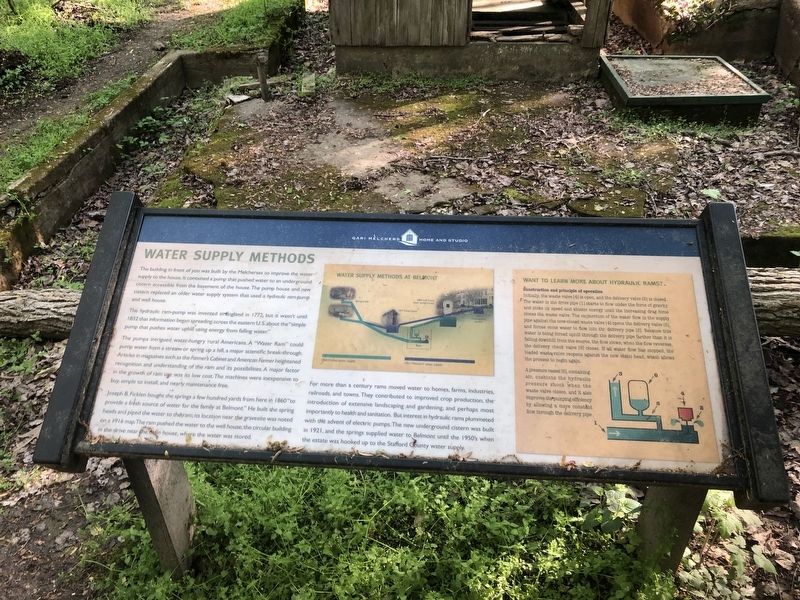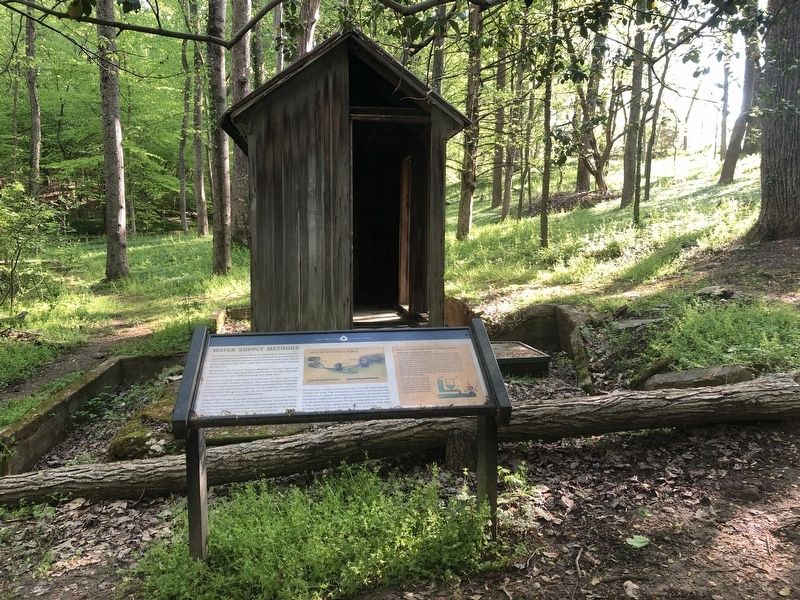Water Supply Methods
Gari Melchers Home and Studio
The building in front of you was built by the Melcherses to improve the water supply to the house. It contained a pump that pushed water to an underground cistern accessible from the basement of the house. The pump house and new cistern replaced an older water supply system that used a hydraulic ram-pump and well house.
The hydraulic ram-pump was invented in England in 1772, but it wasn't until 1832 that information began spreading across the eastern U.S. about the "simple pump that pushes water uphill using energy from falling water."
The pumps intrigued water-hungry rural Americans. A "Water Ram" could pump water from a stream or spring up a hill, a major scientific break-through. Articles in magazines such as the Farmer's Cabinet and American Farmer heightened recognition and understanding of the ram and its possibilities. A major factor in the growth of ram use was its low cost. the machines were inexpensive to buy, simple to install, and nearly maintenance free.
Joseph B. Ficklen bought the springs a few hundred yards from here in 1860 "to provide a fresh source of water for the family at Belmont." He built the spring heads and piped the water to the ram; its location near the gravesite was noted on a 1916 map. The ram pushed the water to the well house, the circular building in the drive
near the main house, where the water was stored.For more than a century rams moved water to homes, farms, industries, railroads, and towns. They contributed to improved crop production, the introduction of extensive landscaping and gardening, and perhaps most importantly to health and sanitation. but interest in hydraulic rams plummeted with the advent of electric pumps. The new underground cistern was built in 1921, and the springs supplied water to Belmont until the 1950's when the estate was hooked up to the Stafford County water supply.
Want to Learn More About Hydraulic Rams?
Construction and principle of operation
Initially, the waste valve [4] is open, and the delivery valve [5] is closed. The water in the drive pipe [1] starts to flow under the force of gravity and picks up speed and kinetic energy until the increasing drag force closes the waste valve. The momentum of the water flow in the supply pipe against the now-close waste valve [4] opens the delivery valve [6], and forces some water to flow into the delivery pipe [3]. Because this water is being forced uphill through the delivery pipe farther than it is falling downhill from the source, the flow slows; when the flow reverses, the delivery check valve [5] closes. If all flow has stopped, the loaded waste valve reopens against the now static head, which allows the
A pressure vessel [6], containing air, cushions the hydraulic pressure shock when the waste valve closes, and it also improves the pumping efficiency by allowing a more constant flow through the delivery pipe.
Topics. This historical marker is listed in these topic lists: Agriculture • Industry & Commerce. A significant historical year for this entry is 1772.
Location. 38° 19.5′ N, 77° 28.505′ W. Marker is in Falmouth, Virginia, in Stafford County. Marker can be reached from Washington Street (Route 1001) 0.2 miles Warrenton Road (Route 17). Touch for map. Marker is in this post office area: Fredericksburg VA 22405, United States of America. Touch for directions.
Other nearby markers. At least 8 other markers are within walking distance of this marker. A Family Memorial (within shouting distance of this marker); Welcome To Our Trails (about 300 feet away, measured in a direct line); A Working Farm (about 500 feet away); Gari Melchers and his wife Corinne (about 600 feet away); Caretaker Cottage (about 600 feet away); Gari Melchers Home and Studio (approx. 0.2 miles away); Capt. John Smith (approx. 0.2 miles away); Transportation and Settlement (approx. 0.2 miles away). Touch for a list and map of all markers in Falmouth.
Credits. This page was last revised on April 24, 2021. It was originally submitted on April 24, 2021, by Devry Becker Jones of Washington, District of Columbia. This page has been viewed 111 times since then and 14 times this year. Photos: 1, 2. submitted on April 24, 2021, by Devry Becker Jones of Washington, District of Columbia.

